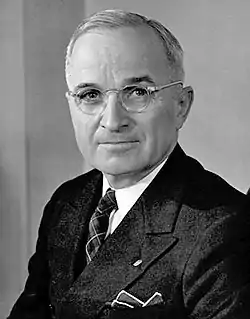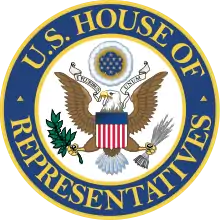Clinton Anderson
Clinton Presba Anderson (October 23, 1895 – November 11, 1975) was an American politician. A member of the Democratic Party, he served as a U.S. Representative from New Mexico from 1941 until 1945, the U.S. Secretary of Agriculture from 1945 until 1948, and a U.S. Senator from New Mexico from 1949 to 1973.
Clinton Anderson | |
|---|---|
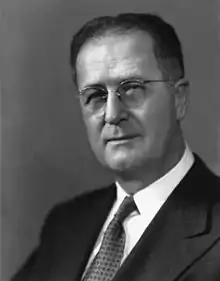 | |
| United States Senator from New Mexico | |
| In office January 3, 1949 – January 3, 1973 | |
| Preceded by | Carl Hatch |
| Succeeded by | Pete Domenici |
| 13th United States Secretary of Agriculture | |
| In office June 30, 1945 – May 10, 1948 | |
| President | Harry S. Truman |
| Preceded by | Claude R. Wickard |
| Succeeded by | Charles F. Brannan |
| Member of the U.S. House of Representatives from New Mexico's at-large district | |
| In office January 3, 1941 – June 30, 1945 | |
| Preceded by | John J. Dempsey |
| Succeeded by | George Lusk |
| 9th Treasurer of New Mexico | |
| In office 1933–1934 | |
| Governor | Arthur Seligman |
| Preceded by | Warren Graham |
| Succeeded by | James Connelly |
| Personal details | |
| Born | Clinton Presba Anderson October 23, 1895 Centerville, South Dakota, U.S. |
| Died | November 11, 1975 (aged 80) Albuquerque, New Mexico, U.S. |
| Political party | Democratic |
| Spouse(s) | Henrietta McCartney |
| Children | 2 |
| Education | Dakota Wesleyan University University of Michigan, Ann Arbor |
Early life and career
Anderson was born in Centerville, South Dakota, on October 23, 1895.[1] His parents were Andrew Jay and Hattie Belle Anderson (née Presba). He was educated in the public school system of South Dakota and attended Dakota Wesleyan University (1913-1915) and the University of Michigan (1915-1916) but never received a degree from either institution.
After his father broke his back in 1916, Anderson left the University of Michigan to go home to help to support his family. He worked for several months for a newspaper in Mitchell, South Dakota, until he became seriously ill with tuberculosis. He was not aware of his illness until he attempted to join the US military in 1917 upon America's entrance into World War I. Doctors gave him six months to live. One gave him the advice to check himself into the Methodist Sanitarium in Albuquerque, New Mexico. He promptly did so, and while recovering there, he occasionally wrote for the Albuquerque Herald.
In 1919, as soon as he was well enough to leave the sanitarium, he gained employment with the Albuquerque Morning Journal, now called the Albuquerque Journal, and he was sent to Santa Fe to cover New Mexico's legislature. Very critical of how the Republican Party was running the state, he befriended some New Mexico Democratic legislators and gave them his ideas on bills before the legislature. Some of the ideas eventually became state law, and Anderson began a lifelong association with the Democratic Party.
His long career of public service began as executive secretary of the New Mexico Public Health Association in 1919. There, he raised money to fight tuberculosis, established county health programs, and was instrumental in founding the state public health department.
On June 22, 1921, Anderson had married Henrietta McCartney, and he returned to Albuquerque with his new wife. They had two children: Sherburne Presba Anderson and Nancy Anderson.
In the early 1920s, Anderson pursued private business affairs. Newspaper work seemed to offer a poor future so in 1922, he started in the insurance business with the New Mexico Loan and Mortgage Company. Anderson was soon able to buy the business and change the name to the Clinton P. Anderson Agency, a successful and enduring enterprise.
Actively involved in the Rotary Club of Albuquerque since 1919, he was elected to the International Board in 1930 and became president of Rotary International in 1932, a position that introduced him to many business and political contacts.
Anderson returned to public life, becoming chairman of the New Mexico Democratic Party in 1928 and state treasurer of New Mexico in 1933. That was followed by appointments as director of the Bureau of Revenue, relief administrator for the State of New Mexico, Western States Field Coordinator for the Federal Emergency Relief Administration, State Director of the National Youth Administration, chairman of the New Mexico Unemployment Security Division, and Managing Director of the Coronado Cuarto Centennial Commission, among others. It was Anderson's style to take on a newly created position or an emergency situation, to organize it, and then to leave when he felt that all was running smoothly.
In 1940, a conflict among members of the state Democratic Party resulted in Congressman John J. Dempsey being disqualified from running for another term as New Mexico's only representative. Party members convinced Anderson to run for the seat, which he won by using his many business and political contacts throughout the state. For the next three decades, he divided his time between Albuquerque and Washington, D.C..

Anderson became known for his thorough investigative work, and during his three terms in the House of Representatives, he was assigned to several special committees, including the chairmanship of the Special Committee to Investigate Food Shortages in 1945. The committee argued for a streamlined food distribution system and emphasized long-range planning for increasing food production. His success in that assignment, along with their personal friendship, led to his appointment by President Harry S. Truman as U.S. Secretary of Agriculture.[2]
Truman administration

Shortly after Harry S. Truman became President in 1945, he selected Anderson to serve as his Secretary of Agriculture. His most immediate concern was the reorganization of the domestic agricultural economy, which for the previous four years, had been focused on supporting the American war effort in the Second World War. Anderson addressed issues such as price controls, shortages, and subsidies, and he played an important role in developing postwar agricultural policies.
The domestic situation was only one of Anderson's concerns as Secretary of Agriculture. The looming worldwide food crisis, which was becoming more evident by 1946, led President Truman to establish the Famine Emergency Committee.
Anderson made two controversial moves to change the drastic problems. Firstly, he used his organizational skills to incorporate all existing food and agricultural activities under his office. Secondly, he advised Truman to enlist former President Herbert Hoover to serve as chairman of the Famine Emergency Committee. During the crisis, Anderson, Truman, and Hoover worked together very closely. Many of Hoover's proposals on alleviating the international food shortage were adopted by the Truman administration, and it became Anderson's responsibility to implement the proposals. The three men can be credited with preventing an even larger international disaster.
US food production and worldwide distribution was stabilized by 1948, and Anderson decided to retire from the Cabinet. As with every project he had undertaken, Anderson left after he had resolved the problems faced.
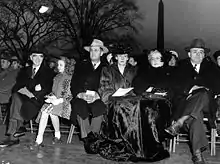
Senate career
Election
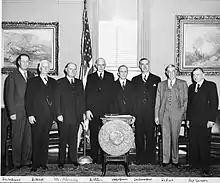
Anderson considered retiring altogether after resigning from the cabinet. However, state Democrats, led by retiring Senator Carl Hatch, convinced Anderson to run for Hatch's seat against the formidable and distinguished diplomat Patrick J. Hurley.
The two well-established candidates faced off in one of the most heated campaigns of the 1948 election. The nationwide campaigning of the Truman administration against an 'obstructionist' Republican Congress made Republicans lose across the country, including Hurley.
Anderson's re-election in 1954 against former Governor of New Mexico Edwin L. Mechem would be less heated but more significant because the Democrats had lost the Senate in 1952. Anderson prevailed, with the Democrats regaining control of the Senate, and went on to be re-elected by wide margins in 1960 and 1966.
Accomplishments
Anderson's main accomplishment as a senator was being one of the most outspoken proponents of the space program. He was instrumental in gaining funding for the program while chairing the Senate Committee on Aeronautical and Space Sciences from 1963 to 1973. As chairman of the committee during the most active period of space exploration and the most important time of the space race, Anderson held a key policymaking role in Washington, not to mention the purse strings for NASA.
Anderson sponsored the final wilderness bill, which passed the Senate by a vote of 73-12 on April 9, 1963, passed the House of Representatives by a vote of 373-1 on July 30, 1964, and it was signed into law by President Lyndon Johnson on September 3, 1964. Richard McArdle, chief of the Forest Service from 1952-1962, remarked, "Without Clinton Anderson there would have been no Wilderness Law."[3] Anderson is also known for the Price-Anderson Nuclear Industries Indemnity Act, and for forcing cancellation of the 1954 Dixon-Yates contract with the AEC for power from the TVA for the city of Memphis.
He also served as chairman of the Joint Committee on Atomic Energy (84th and 86th Congresses), Joint Committee on Construction of Building for Smithsonian (84th-92nd), Joint Committee on Navaho-Hopi Indians (84th-92nd), Special Committee on Preservation of Senate Records (85th and 86th, Committee on Interior and Insular Affairs (87th and 88th), Special Committee on National Fuel Policy (87th).
Failed confirmation of Lewis Strauss
In 1959, President Dwight D. Eisenhower nominated Lewis Strauss to serve as Secretary of Commerce. Previously, Strauss had served in numerous government positions in the administrations of Presidents Truman and Eisenhower. The previous 13 nominees for the Cabinet position had won Senate confirmation in an average of eight days.[4] Because of both personal and professional disagreements, Anderson took up the cause to make sure that Strauss would not be confirmed by the Senate. Anderson found an ally in Senator Gale W. McGee on the Senate Commerce Committee, which had jurisdiction over Strauss's confirmation. During and after the Senate hearings, McGee charged Strauss with "a brazen attempt to hoodwink" the committee.[4] After 16 days of hearings the committee recommended Strauss's confirmation to the full Senate by a vote of 9-8. In preparation for the floor debate on the nomination, the Democratic majority's main argument against the nomination was that Strauss's statements before the committee were "sprinkled with half truths and even lies... and that under rough and hostile questioning, [he] can be evasive and quibblesome."[4]
Despite an overwhelming Democratic majority, the 86th United States Congress was not able to accomplish much of its agenda since the President had immense popularity and a veto pen.[4] With the 1960 elections nearing, congressional Democrats sought issues on which they could conspicuously oppose the Republican administration. The Strauss nomination proved to be tailor-made.[5]
Just after midnight on June 19, 1959, the Strauss nomination failed by a vote of 46-49. It marked only the eighth time in U.S. history that a Cabinet appointee had failed to be confirmed by the Senate.[6]
Later life
His age and growing health problems made Anderson retire on January 3, 1973 after he had served four terms in the U.S. Senate. He died at his home in Albuquerque on November 11, 1975 from a massive stroke, and he was buried at Fairview Memorial Park in Albuquerque. His wife, Henrietta McCartney Anderson, died on June 7, 1994, at the age of 94.
He was inducted into the International Space Hall of Fame in 1977.[7]
Popular culture
In the 1998 HBO miniseries From the Earth to the Moon, Anderson was played by Mason Adams.
References
- Ryan, James G.; Leonard C. Schlup (2006). Historical Dictionary of the 1940s. Armonk, NY: M.E. Sharpe. p. 26. ISBN 978-0-7656-2107-8.
- Video: Air Forces Come Home Via Bomber, 1945/05/28 (1945). Universal Newsreel. 1945. Retrieved February 20, 2012.
- "Wilderness.net Clinton Anderson". Retrieved 14 October 2014.
- http://www.time.com/time/magazine/article/0,91771,892639,00.html. Retrieved December 1, 2011. Missing or empty
|title=(help) - "U.S. Senate: Art & History Home > Historical Minutes > 1941-1963 > Cabinet Nomination Defeated". Senate.gov. Retrieved 2011-12-02.
- https://archive.is/20130105000041/http://www.time.com/time/magazine/article/0,91771,864640,00.html. Archived from the original on January 5, 2013. Retrieved December 1, 2011. Missing or empty
|title=(help) - "Space Hall Honors Pioneers". Las Cruces Sun-News. Las Cruces, New Mexico. October 30, 1977. p. 6 – via Newspapers.com.
- United States Congress. "Clinton Anderson (id: A000186)". Biographical Directory of the United States Congress.
External links
| Wikimedia Commons has media related to Clinton Presba Anderson. |
- Clinton P. Anderson Papers, 1848-1975, University of New Mexico, Center for Southwest Research
- Clinton P. Anderson Papers, 1945-1948, Harry S. Truman Library
- Clinton P. Anderson Photographs, 1946-1975, University of New Mexico, Center for Southwest Research
| Non-profit organization positions | ||
|---|---|---|
| Preceded by Sydney Pascall |
President of Rotary International 1932–1933 |
Succeeded by John Nelson |
| Political offices | ||
| Preceded by Warren Graham |
Treasurer of New Mexico 1933–1934 |
Succeeded by James Connelly |
| Preceded by Claude R. Wickard |
United States Secretary of Agriculture 1945–1948 |
Succeeded by Charles F. Brannan |
| U.S. House of Representatives | ||
| Preceded by John J. Dempsey |
Member of the U.S. House of Representatives from New Mexico's at-large congressional district 1941–1945 |
Succeeded by George Lusk |
| Party political offices | ||
| Preceded by Carl Hatch |
Democratic nominee for U.S. Senator from New Mexico (Class 2) 1948, 1954, 1960, 1966 |
Succeeded by Jack Daniels |
| U.S. Senate | ||
| Preceded by Carl Hatch |
U.S. Senator (Class 2) from New Mexico 1949–1973 Served alongside: Dennis Chávez, Edwin L. Mechem, Joseph Montoya |
Succeeded by Pete Domenici |
| Preceded by W. Sterling Cole |
Chair of the Joint Atomic Energy Committee 1955–1957 |
Succeeded by Carl T. Durham |
| Preceded by Carl T. Durham |
Chair of the Joint Atomic Energy Committee 1959–1961 |
Succeeded by Chet Holifield |
| Preceded by James E. Murray |
Chair of the Senate Interior Committee 1961–1963 |
Succeeded by Henry M. Jackson |
| Preceded by Robert S. Kerr |
Chair of the Senate Space Committee 1963–1973 |
Succeeded by Frank Moss |

